Western Digital and Seagate: 320GB Grudge Match
by Gary Key on July 27, 2006 2:00 AM EST- Posted in
- Storage
IPEAK Game Installation Tests
Our IPEAK based Game Installation benchmarks simply show the ability of the hard drive to write data as quickly as possible to the disc based upon the installation software instructions. As detailed in our IPEAK setup description we installed the games from our source drive in order to eliminate the optical drive bottleneck. In separate application timing we witnessed basically the same percentage spread when installing the games via our DVD drive so these results are representative of actual installation performance.
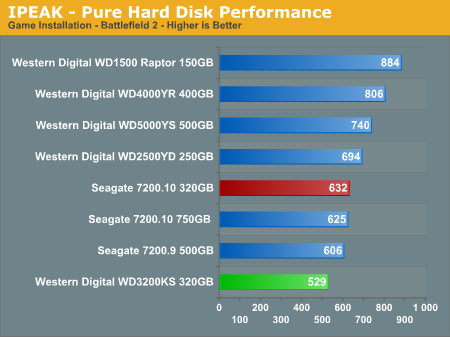
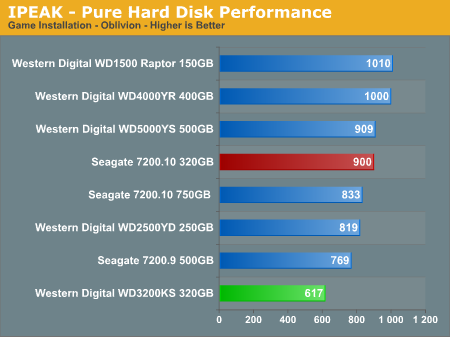
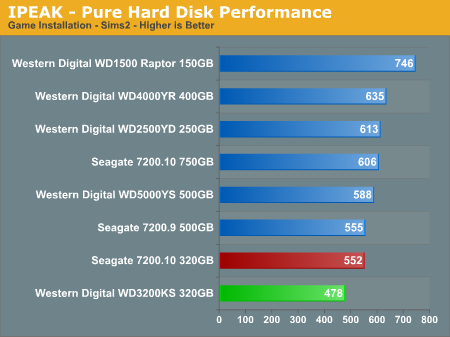
The Seagate 7200.10 320GB drive simply dominates the WD3200KS in these tests with performance differences up to 45%. While this is impressive, we need to remember these tests reflect pure hard drive performance and will be mitigated by the overall system platform as we will see in our application tests. These tests are basically designed around continual requests, something the Seagate 7200.10 drives excel at. Any defragmentation program will be Seagate's best friend based upon our results.
IPEAK Game Play Tests
The IPEAK based Game Play tests are centered on the benefits of having a hard disk that can load non-linear or sequential data files quickly without interrupting the flow of the game.
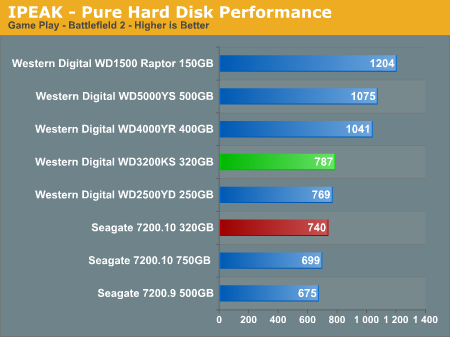

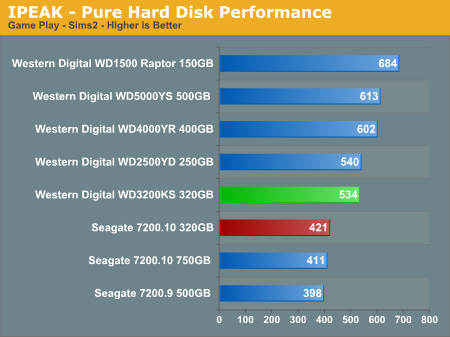
Sounding like a broken record, the WD Raptor places first as its 10k rpm spindle speed and optimized cache play an important role in its ability to sustain high transfer rates. However, the WD3200KS comes back and posts a knockout against the 320GB Seagate with up to a 28% performance lead. While these differences sound large, in actual desktop usage most users will not be able to tell the difference except when utilizing the Raptor in certain situations. These tests certainly reflect what you would see during game play and the non-sequential nature of the requests favor the Western Digital drives.
Our IPEAK based Game Installation benchmarks simply show the ability of the hard drive to write data as quickly as possible to the disc based upon the installation software instructions. As detailed in our IPEAK setup description we installed the games from our source drive in order to eliminate the optical drive bottleneck. In separate application timing we witnessed basically the same percentage spread when installing the games via our DVD drive so these results are representative of actual installation performance.



The Seagate 7200.10 320GB drive simply dominates the WD3200KS in these tests with performance differences up to 45%. While this is impressive, we need to remember these tests reflect pure hard drive performance and will be mitigated by the overall system platform as we will see in our application tests. These tests are basically designed around continual requests, something the Seagate 7200.10 drives excel at. Any defragmentation program will be Seagate's best friend based upon our results.
IPEAK Game Play Tests
The IPEAK based Game Play tests are centered on the benefits of having a hard disk that can load non-linear or sequential data files quickly without interrupting the flow of the game.



Sounding like a broken record, the WD Raptor places first as its 10k rpm spindle speed and optimized cache play an important role in its ability to sustain high transfer rates. However, the WD3200KS comes back and posts a knockout against the 320GB Seagate with up to a 28% performance lead. While these differences sound large, in actual desktop usage most users will not be able to tell the difference except when utilizing the Raptor in certain situations. These tests certainly reflect what you would see during game play and the non-sequential nature of the requests favor the Western Digital drives.










20 Comments
View All Comments
patentman - Monday, July 31, 2006 - link
To avoid superparamagnetism, engineers have been increasing the coercivity, the field size required to write a bit, of the disc media. These fields are limited by the magnetic materials making up the write head that will soon effectively limit drive sizes utilizing longitudinal recording. Although additional capacities are still achievable, the drive industry will be moving to perpendicular recording technology shortly as longitudinal recording has basically hit the proverbial brick wall after being utilized for nearly 50 years."I wrote a pretty detailed post on the anandtech forums about this a while back. You can check it out http://forums.anandtech.com/messageview.aspx?catid...">here" (I used to post under the nickname "klaviernista"). Considering I examined and issued a lot fo the patents that are the basis of seagate's perpendicular technology, I think I am more than qualified to speak on the matter.
Oh, and for the record, the "soft" magent under layer is never truly "written to" during the reocrind gprocess. The soft magnetic underlayer is made of a material that has magnetic domains which rotate easily in response to an external magentic field. When the write field goes across any given point in the medium, it induces the field in the corresponding point on the soft magentic underlayer to rotate perpendicular to the medium. The article is correct in saying that the result is a substantial increase in write field intensity, but neglects to mention that the fields of the soft magnetic underlayer to not remain oriented perpendicular to the media surface after the write field from the magentic head is removed, whereas the fields in the magentic recording layer do remain oriented perpendicular to the media surface.
The whole point of usuing a soft magnetic underlayer is to allow magnetic materials with very high coercivity to be used as the recoprding layer. Why do you need a very high coercivity recording layer in high density recordng media? See the post I linked to above and read the discussed about "intergranular exchange coupling."
jackylman - Thursday, July 27, 2006 - link
In the pulldown menu, accoustics -> acousticsSonicIce - Thursday, July 27, 2006 - link
Even with an extra platter to lug around, the Western Digital was quieter and cooler!madfly - Thursday, July 27, 2006 - link
if you want to have the seagate hard drive cross shipped where they send you a replacement and you return the defective one back to them they charge $25, considering the hard drive cost $99, that there is a ripoff. I had this happen to me with a 250GB HD that I bought last year, so I'll be spending my money with one of the others unless the deal is ridiculous.Mana211 - Thursday, July 27, 2006 - link
SPCR uses 1 meter (aka 1000mm or 200 times your stated distance) to measure SPL."Each drive is measured for SPL one meter away from the top of the hard drive. Hard drive noise tends to be directional, the loudest position being directly over the top. SPL readings typically drop by 2~3 dBA/1m when measured from the side of the drive. The drive is placed on a soft foam to ensure that no vibration noise is produced during testing."
The there is an entire category of sounds you hear at 5mm that wouldn't be noticable from outside a case.
Take this quote from SPCR: "Consider the distance of Hardware.fr's recording microphone: 5cm from the HDD. This is a serious problem. There's no way the decibel reading can be accurate due to boundary effects. It's the same problem at storagereview.com -- not even relative differences are necessarily correct due to compression effects; the close proximity impacts every measurement similarly, reducing differences."
http://www.silentpcreview.com/article631-page1.htm...">http://www.silentpcreview.com/article631-page1.htm... shows that the new audio recordings (not to be confused with the SPL Dba numbers) will use two recording distances:
* One meter so that "nominal" volume, audibility, and sound character can be judged.
* One foot (or 30 cm if you will) to capture all the details from even the quietest noise sources.
tuteja1986 - Thursday, July 27, 2006 - link
Western digital for me since i want a quiet and cool drive.crydee - Thursday, July 27, 2006 - link
The WD400YR and WD500YS seem very close to performance with the Raptor, but I can't find the WD400YR on pricewatch on newegg also I read about the WD drivers having a high rate of doa?AdamK47 3DS - Thursday, July 27, 2006 - link
The Seagate drive has a performance advantage with the two 160GB platters. Anandtech is still ignoring the advantages of higher platter densities. Why is that? Platter density is one of the features I look at when purchasing a new drive. It's a good indication of performance when compared to another drive of the same total capacity. You have two 320GB drives reviewed with different number of platters and yet there is no mention of this other than the table. It's very odd.evilharp - Thursday, July 27, 2006 - link
Check your "price bot" settings. Currently you list the following deals for a "Western Digital Caviar® SE16"I followed the Business Computing Network link (simply due to the crazy price) and it is for a 20 unit bulk purchase.
Booty - Thursday, July 27, 2006 - link
On the last page it should be listed that the WD has a 3 year warranty for retail and 1 year for OEM - you have them switched.